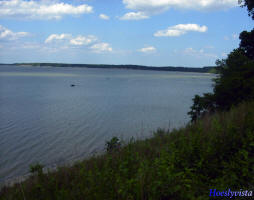 Spain
Spain
| Released | 13/02/2006 |
|---|
Júcar Pilot River Basin: Works developedprovided by Confederación Hidrográfica del Júcar
The Pilot River Basin selected in Spain in 2002 to implement the Guide Documents of the European Water Framework Directive (WFD) is the Júcar Basin. The Júcar River Basin District (RBD) covers an area of 42.989km2. The Júcar Authority has taken on the task of accepting the implementation of all Guide Documents presented in the WFD by the EU. The Júcar RBD presented a report early in 2004 which included those works developed up to date as established in Article 5 of the Directive. This report includes:
- an analysis of the River Basin District characteristics
- a review of the impact of human activity on the status of surface waters and groundwater
- an economic analysis of water use.
In order to include this information, the report has followed the technical specifications set out in Annexes II and III of the WFD. In addition, the report includes two sections where the goals established in articles 3 and 6 are described:
- coordination of administrative arrangements within the River Basin Districts and
- register of protected areas.
The Júcar River Basin presents an irregular hydrology that might present drought and flood episodes even during the same year, which hinders the process of establishing a balance between water demand and supply.
The section on characterisation of the Júcar Pilot River Basin describes how this phase has been developed through different activities: the definition of surface water bodies and groundwater bodies using a national GIS model, the classification of the existing ecotypes, the selection of reference conditions according to these ecotypes, and the use of the concept hydrogeological unit for the characterisation of groundwater bodies. The third chapter of the report covers the register of protected areas, which includes identification of areas designated for the abstraction of water intended for human consumption; areas for the protection of aquatic species that are economically significant; water bodies designated for recreational use; nutrient-sensitive areas; and areas designated for the protection of habitats or species.
The report continues with an analysis of all significant anthropogenic pressures, as point source pollution or diffuse source pollution, to evaluate the risk of failing the environmental quality objectives established by the WFD for each water body.
This identification has been developed by following the Manual of pressures and impacts of the General Directorate of Water.
Within this section, there is also a description of those methods used for the identification of different pressures and impacts on groundwaters, surface, coastal and transitional waters.
Lastly, the report includes an economic analysis of the use of water based on a specific hydraulic system and its associated users, which is a system considered very representative of the Júcar district.
The analysis includes a description of the existing Spanish economic regime for surface waters, in addition to concepts such as the recovery of the costs of water services, estimates of the costs associated with the use of groundwaters and the economical characterisation of water use.


Documents:
- WATER MANAGEMENT AND WATER FRAMEWORK DIRECTIVE: ISSUES AND PROBLEMS
- JÚCAR PILOT RIVER BASIN, PROVISIONAL ARTICLE 5 REPORT, PURSUANT TO THE WATER FRAMEWORK DIRECTIVE.
Jucar Pilot River Bassin Report Foreword: (Júcar River Basin Authority, September 2004)
The legal implementation of the WFD into the
Spanish national legislation occurred on December 31, 2003 by means of
amending the Water Act 1/2001 of July 20. The Act 62/2003 of fiscal,
administrative and social measures, of December 30 gives fulfilment in its
Title V, Chapter V, Article 129, to the requirements of the WFD in terms of
establishing the River Basin Districts, including supervision of inland,
transitional and coastal waters. In addition, a new administrative body,
called the Committee of Competent Authorities is created, where national,
regional and local administrations are created for fostering
inter-administrative cooperation in the application of protective water
legislation.
Another aspect of the transposition of the
Directive is the new regulation that arises for contents, provisions,
objectives and procedures for the elaboration of the River District
Management Plans. This new regulation meets the requirements of the WFD by
fixing the environmental objectives for surface and groundwater, protected
areas, and artificial and heavily modified waters, and by establishing
associated deadlines for those purposes. Finally, public participation
procedures have also been incorporated into the new regulations.
This report aims at putting into perspective
those tasks developed to date by the Júcar RBD regarding the implementation
of the WFD, and more precisely, each of them pursuant to article 5, which
should be developed by all EU River Basin Districts by the end of 2004. It
is also a main objective of this document to spread knowledge acquired on
this subject by the Júcar PRB during the short, but otherwise intense,
period since the year 2002. This report aims at showing other river basins
the steps and procedures that have been adopted in order to implement the
Directive; the tools and techniques used; where and when difficulties have
arisen; and where efforts should be focused based on this experience. To sum
up, its purpose is to show the path followed and the findings obtained as a
PRB.
Although each river basin has its own
identity, similar and comparable basins to the Júcar case will find in this
material a reference point to start working towards the achievement of
article 5 analyses. For those with a different profile, the document
provides approaches that will help to tackle distinctive issues of each RBD.
It is the wish of the Júcar RBD that many other River Basins may find in
this report assistance and guidance for their water management. Moreover, it
is also a major objective of this report to transmit to the general public
and to stakeholders the preliminary outcomes of the application of article
5, as a means to ensure the information supply, since background
information, such as that presented in the document, should be available for
anyone at any time.
It is worth mentioning that the results of this report were obtained thanks to a multidisciplinary working staff, comprised, among others, by engineers, biologists, hydro-geologists, economists and computer experts, from the Júcar RBD’s personnel and from external consultants, who have done their best in order to deal with the diversity of technical and practical questions raised by the WFD. It is clear that the task entailed by the implementation of the new water policy no longer relies on a single-unique discipline, but on inter-disciplinary teams that take into account interactions between water issues and their intricate technical and social complexity. The main characterisation and analysis requirements of article 5 encompass the following activities:
• delineation and characterisation of
surface and groundwater bodies
• establishment of reference conditions for surface water bodies
• identification of pressures
• impact of human activity on the status of surface and groundwater bodies,
by means of a preliminary assessment of the risk of failing to meet the
environmental objectives
• conducting an economic analysis of water use.
Section 3 of this report also includes a description of the Register of Protected Areas. Although this is currently regulated by article 6, it is included here, since the deadline for its establishment is also the end of 2004.
 you are not logged in
you are not logged in





